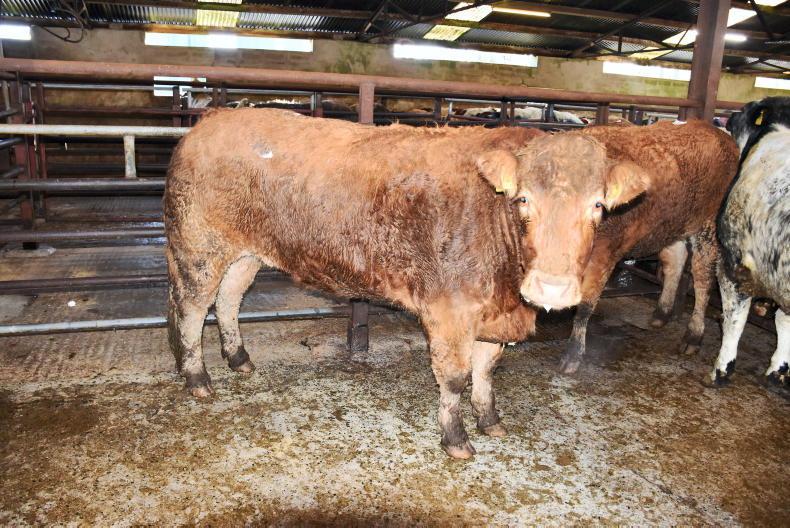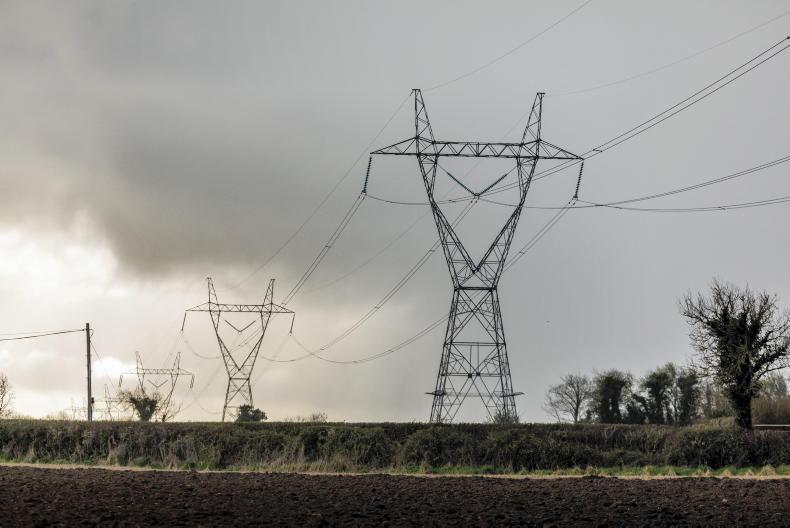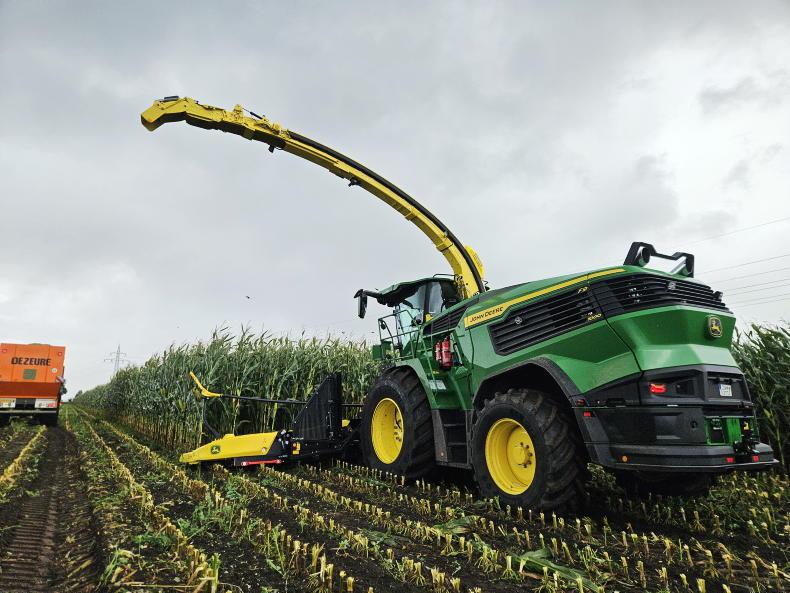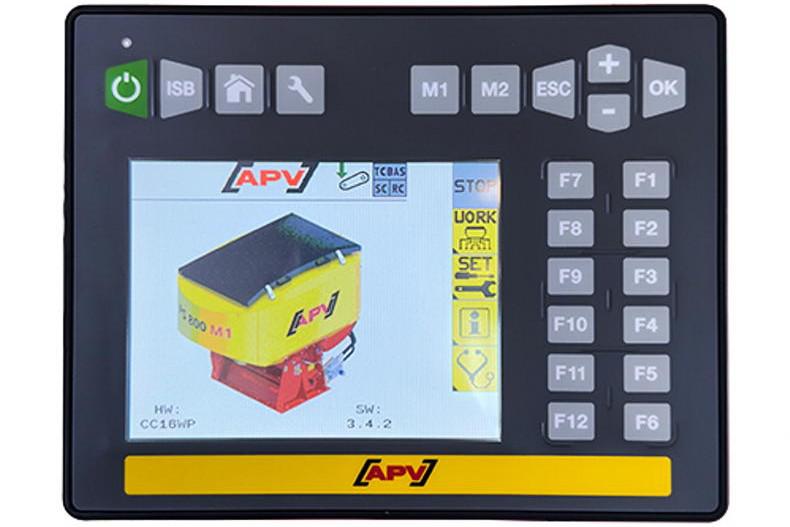Based outside the small village of Poyntzpass in Co Armagh, near the border of Co Down, Ivan Megaw and his son Willie are third- and fourth-generation agricultural contractors.
A well-known name in machinery circles, the family business runs one of the largest modern contracting fleets in the country. The Orchard County contractors are massive, and offer practically all farm machinery-related services that span a 30-mile radius. Silage is the biggest part of the business, but the tillage and slurry operations are also huge.
“We are very lucky in our area that 40% to 50% of the silage work we do is in a four-cut system. Last year, we cut over of 10,000 acres of grass silage and wholecrop. We also do a lot of ploughing and sowing. We run five ploughs and are ploughing around 3,000 acres each year.
“The beet side of the business has grown substantially, and this year at the request of our customers we have bought a maize drill,” explained Willie.
Machinery
The family run a total of 16 tractors, which includes 13 John Deeres, two Fendts and one New Holland.
This breaks down to include two 6930s, a 6130R, a 6150R, three 6155Ms, a 6175M, a 6195R and four 6155Rs.
The Fendts include a 939 and a 720 and the New Holland is a T7.230.

A 24m Tramspread dribble bar is used for top dressing crops, which Willie says has become big business since the rise in fertiliser prices a few years ago.
“We ran all John Deere up until 2014 when we bought out first new Fendt. We really like our John Deeres; they are a great, reliable tractor.
“However, I do think the Fendt is the Rolls-Royce of tractors and would be my own go-to tractor. We bought a new New Holland last autumn. It was out of character for us, but to be honest, this decision was solely based on price.
“Spec for spec, it was over £20,000 less than the same spec John Deere. It has been proving to be a great tractor, with a serious cooling system.”

"We plough 3,000 acres each year, and sow a good 70-80% of that".
The family has always run John Deere harvesters, and does not intend to change this anytime soon.
“We run a 9700 and an 8500. We have a great relationship with the John Deere mechanics.”
With a history of running Manitou, Redrock and then JCB and Volvo loaders on the pit, the family has settled on a split of both. They currently run a Volvo L110H and a JCB 419S.
“We mow with four sets of Claas butterfly mowers, they are serious mowers to stick the pace. Parts are expensive, but they are very reliable. We have a mix of Claas and Krone two- and four-rotor rakes. Both have good and bad points.

"We have 10 to 12 full-time staff, some of which have been working with us for over 30 years".
“Last year we bought a new Kuhn 1090 merger. It has been a real love-hate relationship. When it’s going good, it’s great. But when it goes wrong, it goes very wrong. We are in very stoney county, and farmers don’t tend to roll the ground anymore. We find that the merger is a serious tool to send into stoney reseeds. It definitely has a place in the business, but I wouldn’t be rushing out to buy another one,” said Willie.

"We have one dedicated member of staff who spreads fertiliser and sprays for six to eight months of the year.”
Ploughing and sowing is big business for the Megaws. “We run five Kverneland ploughs and we wouldn’t change away from them. You could plough thousands of acres with a Kverneland plough, and you will sell it no bother.
“There’s no other plough out there that you could say the same with. We have demonstrated almost all other brands of ploughs, and I think that the Amazone would be our next choice after the Kverneland.
“We plough 3,000 acres each year, and sow a good 70% to 80% of that. Our main drill is a 6m Kuhn combination drill.
“With six seasons and 10,000 acres through it, we rebuilt it over the winter months at a cost of £7,500 on parts. It has been a hugely reliable machine. We harvest a lot of what we sow with three Claas combines.
“We sow, spray and harvest 450 acres of beet, and wash the majority of it through a Cross machine. The beet has really taken off in recent years.
“Spraying is probably my own favourite job. Between the crops and the liquid fertiliser, we are covering about 12,000 acres each year. We run a self-propelled Bateman and a front- and rear-mounted Hardi combination outfit. We have one dedicated member of staff, who spreads fertiliser and sprays for six to eight months of the year,” said Willie.

"We find that the merger is a serious tool to send into stoney reseeds."
“The amount of kit you need for modern-day slurry contracting is serious. Slurry and digestate work probably accounts for around 30% of our annual business,” said Willie.
The fleet includes two umbilical systems, both which are 12m twin-macerator SlurryQuip dribble bars, which use Bauer and Criman pumps.
A 24m Tramspread dribble bar is used for top-dressing crops, which Willie says has become big business since the rise in fertiliser prices a few years ago.
Aside from 600m of 5in hose to feed, the business uses 4in hose, with Willie saying that the steep terrain would make it impossible to pull larger diameter piping. A fleet of six lorries, three 4,000-gallon and two 3,000-gallon tandem-axle Redrock tankers keep the slurry hauled to the umbilical systems.
With Doda pumps mounted on the slurry tankers for direct pumping, Willie says if the slurry is in good order, these pumps are fit to pump 1,000m to 1,200m.
The business is considering buying a self-propelled Vervaet slurry tanker for injection, or possibly going down the route of a Claas Xerion with a big tanker. Willie says they work on a lot of flinty ground, and sharp stones cutting the umbilical piping is a problem.
Staff
“We have 10 to 12 full-time staff, some of which have been working with us for over 30 years. Some of our staff are part-time farmers, and might work with us for three or four days a week during the winter months. In the summer months, we employ a lot of seasonal staff to get through the busy workload.

“To be honest, our biggest challenge this year has been getting money in the door, like all contractors, we are struggling with it this year more so than other years".
“Back in 2009, I worked in the South Island of New Zealand with a contractor. A guy I worked with over there bought that business, and we have remained good friends ever since. A few years ago, two of his Kiwi staff came over here for a season. They were great lads.
“This year, we have three Kiwis coming over for the summer months. Good staff are important. It’s easy to plan and organise work if you have good staff,” said Willie.
Invoicing
“I’m extremely lucky that my wife Stephanie likes paperwork. I honestly don’t know what I would do without her. She does all the invoicing, and I help out on the wet days. We use the Sage accounts package.
“Invoices are emailed and posted out on a regular basis. We have lots of customers on monthly payments, which is important. Every business needs cashflow to stay operational. My wife has revolutionised the business. The office work is a full-time job and we couldn’t stay operational without it,” said Willie.
Biggest challenges and opportunities
“To be honest, our biggest challenge this year has been getting money in the door. Like all contractors, we are struggling with it this year more so than other years. Money is tight in farming at the minute, everyone is feeling the pinch.
“Other challenges we are facing are the cost of wages, and trying to recruit good staff. The cost of machinery and spare is obviously a massive problem for everyone, it’s gone out of hand. High finance rates are also a challenge right now.
“In terms of opportunities, we are looking into slurry injection and slurry separation. We have got into supplying and applying liquid fertiliser and this is working out well, particular the response we are getting in drought weather in comparison to granulated fertiliser. We are lucky to be positioned in a nicely mixed farming area.
“We have some big dairy, tillage and pig farmers near us. Our customers have got bigger over the years and we have grown with them,” explained Willie.
Best machine owned
“We are very keen on our John Deere 6930s. We’ve had 10 over the years and I still have two, one with 18,000 hours and the other with just 8,000 hours, which we try to use as little as possible.
“We’ve upgraded a lot fresher tractors for different reasons, but we’ve kept the 6930s.
“Aside from some bits of engine trouble, we have found them to be a fantastic machine. They are a lovely size and a very capable, gutsy tractor. We’ve ran several of them to over 20,000 hours.”
Worst machine owned
“We’ve had several over the years but the worst has to be a Herbst PTO powered stone crusher. We had loads of work for it, but we struggled to keep it working. The idea was great, but it didn’t fulfil our expectations. We bought it new but only kept it for just over two years. We bought a new set of John Deere butterfly mowers with groupers in 2011. They came with a transport wheel and they were unbelievably heavy. They were disappointing. We ran them on a John Deere 7280R and it was just able for them.”
“Our business has doubled in size over the last 10 years and we are really happy where we are at right now.
“We plan to try and stay at our current size and keep running a modern fleet of machinery. The next move for us is to increase our own farming business.
“We are farming 500 acres of mostly crops, with some beef cattle.
“We had 70 sucklers at one stage but we are back to 24 cows now.
“We intend on increasing livestock numbers, and putting an emphasis on finishing livestock on a multi-cut silage system and on our own grown crops, such as barley and beet,” concluded Willie.
Based outside the small village of Poyntzpass in Co Armagh, near the border of Co Down, Ivan Megaw and his son Willie are third- and fourth-generation agricultural contractors.
A well-known name in machinery circles, the family business runs one of the largest modern contracting fleets in the country. The Orchard County contractors are massive, and offer practically all farm machinery-related services that span a 30-mile radius. Silage is the biggest part of the business, but the tillage and slurry operations are also huge.
“We are very lucky in our area that 40% to 50% of the silage work we do is in a four-cut system. Last year, we cut over of 10,000 acres of grass silage and wholecrop. We also do a lot of ploughing and sowing. We run five ploughs and are ploughing around 3,000 acres each year.
“The beet side of the business has grown substantially, and this year at the request of our customers we have bought a maize drill,” explained Willie.
Machinery
The family run a total of 16 tractors, which includes 13 John Deeres, two Fendts and one New Holland.
This breaks down to include two 6930s, a 6130R, a 6150R, three 6155Ms, a 6175M, a 6195R and four 6155Rs.
The Fendts include a 939 and a 720 and the New Holland is a T7.230.

A 24m Tramspread dribble bar is used for top dressing crops, which Willie says has become big business since the rise in fertiliser prices a few years ago.
“We ran all John Deere up until 2014 when we bought out first new Fendt. We really like our John Deeres; they are a great, reliable tractor.
“However, I do think the Fendt is the Rolls-Royce of tractors and would be my own go-to tractor. We bought a new New Holland last autumn. It was out of character for us, but to be honest, this decision was solely based on price.
“Spec for spec, it was over £20,000 less than the same spec John Deere. It has been proving to be a great tractor, with a serious cooling system.”

"We plough 3,000 acres each year, and sow a good 70-80% of that".
The family has always run John Deere harvesters, and does not intend to change this anytime soon.
“We run a 9700 and an 8500. We have a great relationship with the John Deere mechanics.”
With a history of running Manitou, Redrock and then JCB and Volvo loaders on the pit, the family has settled on a split of both. They currently run a Volvo L110H and a JCB 419S.
“We mow with four sets of Claas butterfly mowers, they are serious mowers to stick the pace. Parts are expensive, but they are very reliable. We have a mix of Claas and Krone two- and four-rotor rakes. Both have good and bad points.

"We have 10 to 12 full-time staff, some of which have been working with us for over 30 years".
“Last year we bought a new Kuhn 1090 merger. It has been a real love-hate relationship. When it’s going good, it’s great. But when it goes wrong, it goes very wrong. We are in very stoney county, and farmers don’t tend to roll the ground anymore. We find that the merger is a serious tool to send into stoney reseeds. It definitely has a place in the business, but I wouldn’t be rushing out to buy another one,” said Willie.

"We have one dedicated member of staff who spreads fertiliser and sprays for six to eight months of the year.”
Ploughing and sowing is big business for the Megaws. “We run five Kverneland ploughs and we wouldn’t change away from them. You could plough thousands of acres with a Kverneland plough, and you will sell it no bother.
“There’s no other plough out there that you could say the same with. We have demonstrated almost all other brands of ploughs, and I think that the Amazone would be our next choice after the Kverneland.
“We plough 3,000 acres each year, and sow a good 70% to 80% of that. Our main drill is a 6m Kuhn combination drill.
“With six seasons and 10,000 acres through it, we rebuilt it over the winter months at a cost of £7,500 on parts. It has been a hugely reliable machine. We harvest a lot of what we sow with three Claas combines.
“We sow, spray and harvest 450 acres of beet, and wash the majority of it through a Cross machine. The beet has really taken off in recent years.
“Spraying is probably my own favourite job. Between the crops and the liquid fertiliser, we are covering about 12,000 acres each year. We run a self-propelled Bateman and a front- and rear-mounted Hardi combination outfit. We have one dedicated member of staff, who spreads fertiliser and sprays for six to eight months of the year,” said Willie.

"We find that the merger is a serious tool to send into stoney reseeds."
“The amount of kit you need for modern-day slurry contracting is serious. Slurry and digestate work probably accounts for around 30% of our annual business,” said Willie.
The fleet includes two umbilical systems, both which are 12m twin-macerator SlurryQuip dribble bars, which use Bauer and Criman pumps.
A 24m Tramspread dribble bar is used for top-dressing crops, which Willie says has become big business since the rise in fertiliser prices a few years ago.
Aside from 600m of 5in hose to feed, the business uses 4in hose, with Willie saying that the steep terrain would make it impossible to pull larger diameter piping. A fleet of six lorries, three 4,000-gallon and two 3,000-gallon tandem-axle Redrock tankers keep the slurry hauled to the umbilical systems.
With Doda pumps mounted on the slurry tankers for direct pumping, Willie says if the slurry is in good order, these pumps are fit to pump 1,000m to 1,200m.
The business is considering buying a self-propelled Vervaet slurry tanker for injection, or possibly going down the route of a Claas Xerion with a big tanker. Willie says they work on a lot of flinty ground, and sharp stones cutting the umbilical piping is a problem.
Staff
“We have 10 to 12 full-time staff, some of which have been working with us for over 30 years. Some of our staff are part-time farmers, and might work with us for three or four days a week during the winter months. In the summer months, we employ a lot of seasonal staff to get through the busy workload.

“To be honest, our biggest challenge this year has been getting money in the door, like all contractors, we are struggling with it this year more so than other years".
“Back in 2009, I worked in the South Island of New Zealand with a contractor. A guy I worked with over there bought that business, and we have remained good friends ever since. A few years ago, two of his Kiwi staff came over here for a season. They were great lads.
“This year, we have three Kiwis coming over for the summer months. Good staff are important. It’s easy to plan and organise work if you have good staff,” said Willie.
Invoicing
“I’m extremely lucky that my wife Stephanie likes paperwork. I honestly don’t know what I would do without her. She does all the invoicing, and I help out on the wet days. We use the Sage accounts package.
“Invoices are emailed and posted out on a regular basis. We have lots of customers on monthly payments, which is important. Every business needs cashflow to stay operational. My wife has revolutionised the business. The office work is a full-time job and we couldn’t stay operational without it,” said Willie.
Biggest challenges and opportunities
“To be honest, our biggest challenge this year has been getting money in the door. Like all contractors, we are struggling with it this year more so than other years. Money is tight in farming at the minute, everyone is feeling the pinch.
“Other challenges we are facing are the cost of wages, and trying to recruit good staff. The cost of machinery and spare is obviously a massive problem for everyone, it’s gone out of hand. High finance rates are also a challenge right now.
“In terms of opportunities, we are looking into slurry injection and slurry separation. We have got into supplying and applying liquid fertiliser and this is working out well, particular the response we are getting in drought weather in comparison to granulated fertiliser. We are lucky to be positioned in a nicely mixed farming area.
“We have some big dairy, tillage and pig farmers near us. Our customers have got bigger over the years and we have grown with them,” explained Willie.
Best machine owned
“We are very keen on our John Deere 6930s. We’ve had 10 over the years and I still have two, one with 18,000 hours and the other with just 8,000 hours, which we try to use as little as possible.
“We’ve upgraded a lot fresher tractors for different reasons, but we’ve kept the 6930s.
“Aside from some bits of engine trouble, we have found them to be a fantastic machine. They are a lovely size and a very capable, gutsy tractor. We’ve ran several of them to over 20,000 hours.”
Worst machine owned
“We’ve had several over the years but the worst has to be a Herbst PTO powered stone crusher. We had loads of work for it, but we struggled to keep it working. The idea was great, but it didn’t fulfil our expectations. We bought it new but only kept it for just over two years. We bought a new set of John Deere butterfly mowers with groupers in 2011. They came with a transport wheel and they were unbelievably heavy. They were disappointing. We ran them on a John Deere 7280R and it was just able for them.”
“Our business has doubled in size over the last 10 years and we are really happy where we are at right now.
“We plan to try and stay at our current size and keep running a modern fleet of machinery. The next move for us is to increase our own farming business.
“We are farming 500 acres of mostly crops, with some beef cattle.
“We had 70 sucklers at one stage but we are back to 24 cows now.
“We intend on increasing livestock numbers, and putting an emphasis on finishing livestock on a multi-cut silage system and on our own grown crops, such as barley and beet,” concluded Willie.


















SHARING OPTIONS